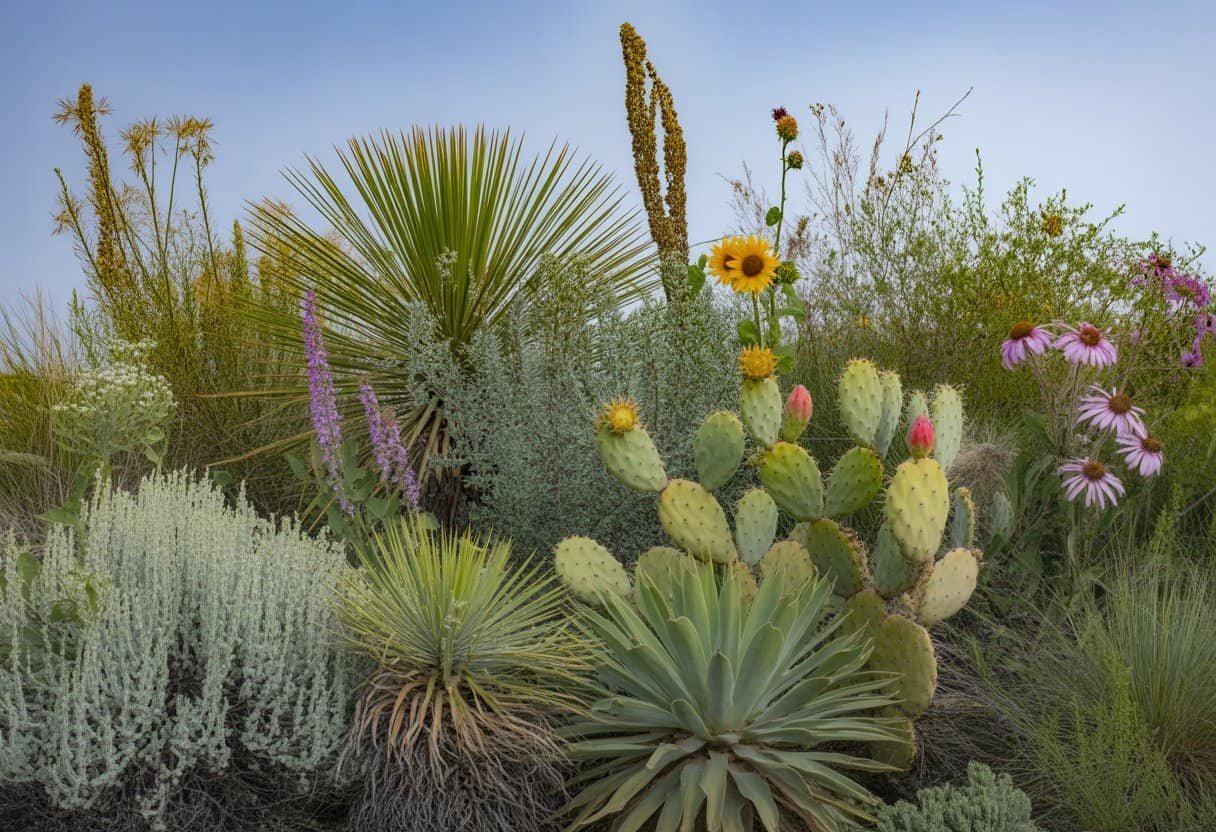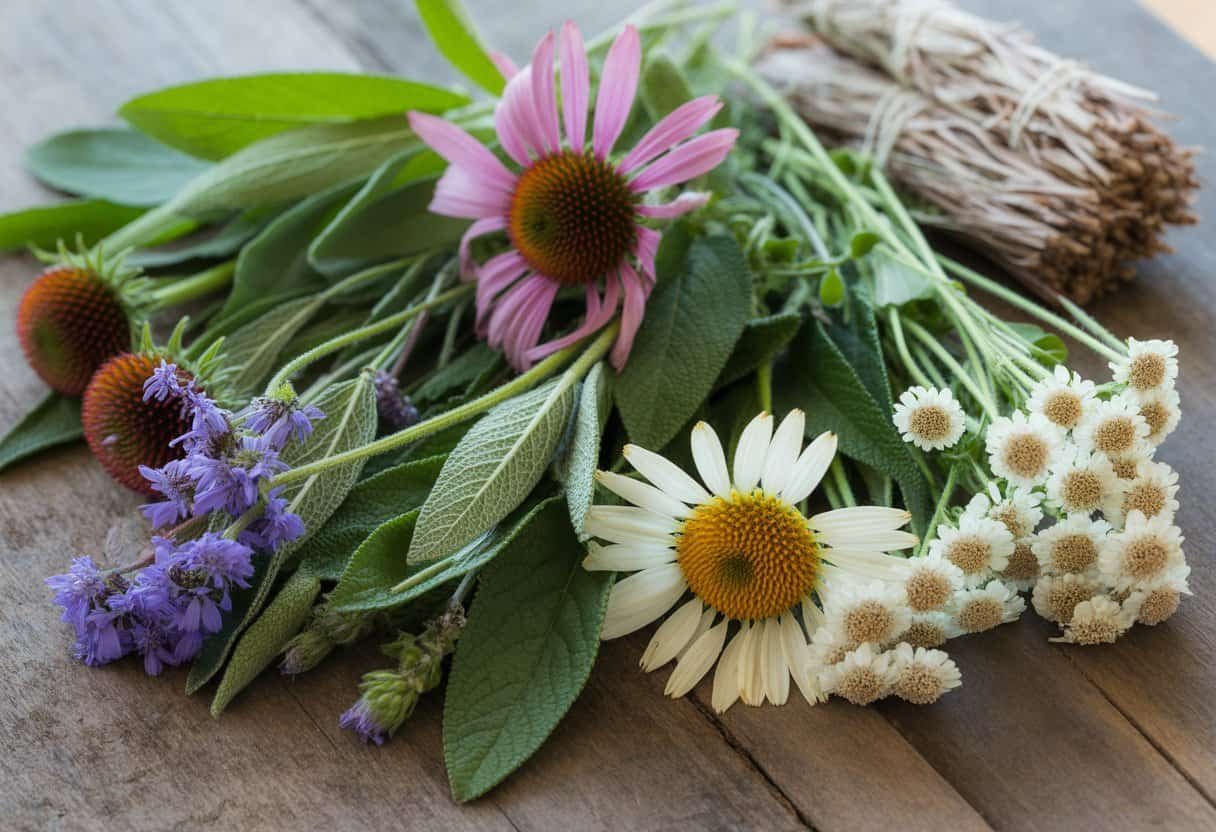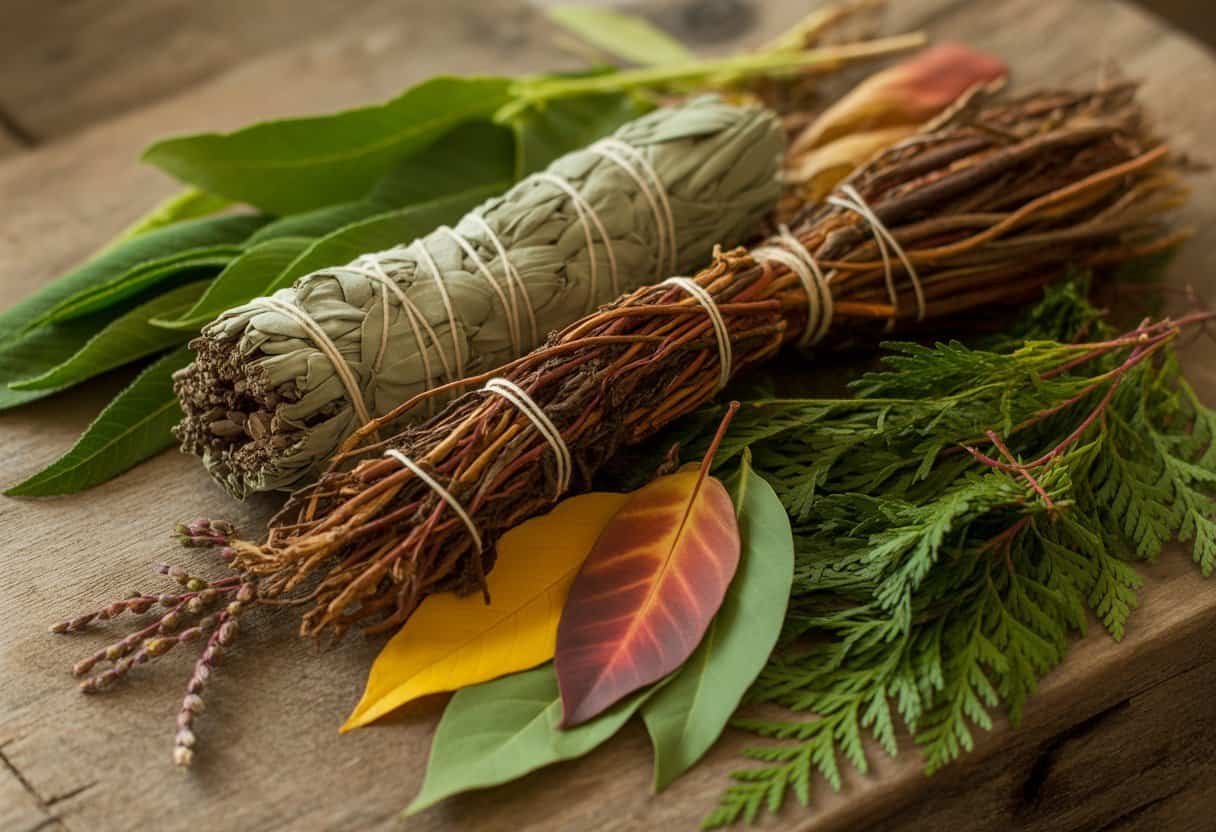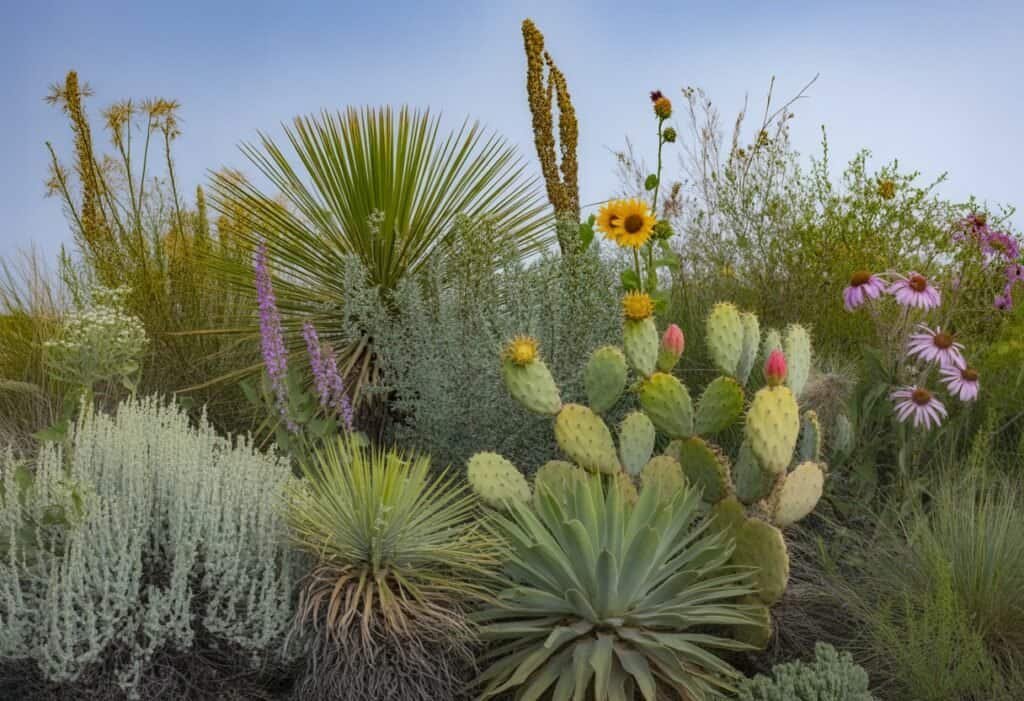Native American plants shaped the landscape of North America for thousands of years before European settlers arrived. These plants provided food, medicine, and shelter, and played key roles in cultural traditions for indigenous peoples across the continent.
Native American plant knowledge is among the oldest and most comprehensive botanical systems in the world. Tribes across different regions documented uses for thousands of plant species.

Many of these plants still thrive today. They offer valuable lessons about sustainability and resilience.
The Three Sisters (corn, beans, and squash) agricultural system and medicinal plants like echinacea and goldenseal have influenced modern gardening, agriculture, and herbal medicine. These plants adapted to local conditions over millennia, making them well suited to their environments.
Key Takeaways
- Native American plant knowledge includes thousands of species used for food, medicine, and spiritual practices across North America.
- Indigenous agricultural techniques developed over generations show sustainable growing methods still valuable today.
- Many traditional Native American medicinal plants have been scientifically validated and now play roles in modern healthcare.
Native American Ethnobotany
Native American tribes built deep relationships with plants over thousands of years. They used plants for medicine, food, tools, and ceremonies.
This knowledge passed down through generations and remains vital to tribal identity and survival.
Cultural Importance of Plants
Plants hold sacred status in many Native American traditions. They connect people to the spiritual world and their ancestors.
Many tribes conduct ceremonies that honor plants with song, dance, and prayer. Cedar, tobacco, sage, and sweetgrass form the “sacred four” for many tribes.
These plants cleanse spaces, offer protection, and open spiritual connections. The harvesting process is sacred.
Many Native Americans offer tobacco or prayers before gathering plants. This shows respect for the plant’s sacrifice.
Plant knowledge distinguishes tribal healers and medicine people. Their skill in identifying, gathering, and preparing plant medicines brings respect within their communities.
Traditional Plant Use
Native Americans used plants for many practical purposes. Food plants included the “Three Sisters“—corn, beans, and squash—grown together to support each other’s growth.
Medicinal uses were extensive:
- Echinacea: Plains tribes used it for pain relief and infections.
- Willow bark: Used for pain and fever; contains salicin, similar to aspirin.
- Elderberry: Made into syrup for colds and respiratory infections.
- Yarrow: Applied to wounds to stop bleeding.
Tribes wove baskets from willow, cedar, and sweetgrass. They built homes from cattails, reeds, and bark.
Roots, berries, and bark provided dyes for textiles. Black walnut hulls made brown dyes, and goldenrod produced yellow.
Historical Context
Plant knowledge developed over thousands of years through observation and experimentation. Each region produced distinct plant traditions based on local ecosystems.
European colonization disrupted these practices. Many tribes lost access to ancestral lands and the plants they knew.
Government policies often banned Native ceremonies involving sacred plants. Despite these challenges, plant knowledge survived.
Tribal elders preserved information through oral traditions. Today, many tribes document their ethnobotanical heritage in books and digital archives.
At least 175 drugs in use today began with Native American plant use. Pharmaceutical companies continue to study traditional plant remedies.
Tribal colleges now offer ethnobotany courses. These help younger generations reconnect with their plant heritage.
Notable Native American Medicinal Plants

Native American tribes developed extensive knowledge of local plants for healing. These natural medicines were vital for treating many ailments before modern medicine.
Echinacea and Its Uses
Echinacea, or purple coneflower, stands among the most important medicinal plants used by Plains tribes like the Lakota and Comanche. These tribes used all parts of the plant—roots, leaves, and flowers—for different conditions.
Native healers applied echinacea to wounds, burns, and insect bites for its anti-inflammatory effects. They made teas and tinctures to fight infections and boost immunity.
Modern research confirms many traditional uses. Studies show echinacea can:
- Stimulate immune system function
- Reduce inflammation
- Help fight upper respiratory infections
- Accelerate wound healing
Today, echinacea remains popular in herbal remedies for colds and flu.
Willow: Precursor to Aspirin
Native Americans across North America recognized willow bark’s pain-relieving properties. Tribes like the Cherokee, Blackfoot, and Iroquois harvested and prepared willow bark to treat headaches, fever, and joint pain.
Willow bark contains salicin, which the body converts to salicylic acid. This compound works like modern aspirin.
People chewed fresh bark, made tea from dried bark, or created poultices for external pain. Willow bark provides slower, longer-lasting relief and may cause less stomach irritation than synthetic aspirin.
Black Cohosh and Women’s Health
Black cohosh (Actaea racemosa) played an important role in Native American women’s health. The Algonquin and Cherokee tribes valued this woodland plant for female-specific conditions.
Women used black cohosh root to ease menstrual cramps, reduce childbirth pain, balance hormones during menopause, and treat reproductive disorders. Traditional healers made teas and tinctures from the roots, often combining black cohosh with other herbs.
Today, black cohosh supplements are popular for menopausal relief. Some clinical studies suggest it may reduce hot flashes and mood changes.
Yarrow for Healing and Antimicrobial Benefits
Yarrow earned the nickname “wound wort” from centuries of battlefield use. Native tribes like the Navajo and Pawnee relied on this versatile plant for its healing properties.
Crushed fresh yarrow leaves, applied to wounds, help stop bleeding, fight infection, reduce inflammation, and speed tissue repair. Tribes also brewed yarrow tea for fevers, digestive problems, and respiratory infections.
Yarrow contains over 120 active compounds. Modern research confirms its antimicrobial effects against bacteria and fungi.
Sacred Plants in Native American Traditions

Many plants hold deep spiritual significance in Native American cultures. People harvest, prepare, and use these plants with care, following traditions passed down for generations.
Tobacco Rites and Social Use
Tobacco (Nicotiana spp.) stands as one of the most sacred plants for many tribes. Unlike commercial tobacco, traditional tobacco is grown and prepared for ceremonies.
Tribes like the Lakota offer tobacco as a gift when asking for guidance or giving thanks. The smoke from burning tobacco carries prayers to the Creator.
In social contexts, people share tobacco in peace pipes during important gatherings and treaty signings. The Navajo use it in healing ceremonies, and the Ojibwe consider it the first plant given by the Creator.
Tribes grow tobacco in special gardens and harvest it with prayers of gratitude.
Sage and Sweetgrass in Ceremonies
White sage (Salvia apiana) and sweetgrass (Hierochloe odorata) play central roles in purification ceremonies. People burn sage in smudging rituals to cleanse spaces, objects, and people of negative energies.
The scent of burning sage attracts positive spirits and drives away negative ones. Many tribes bundle dried sage leaves for storage and use in ceremonies.
Sweetgrass, often braided when dried, represents kindness and healing. When burned, its sweet scent is thought to invite good spirits and positive energy.
Common Ceremonial Uses:
- Purification before important events
- Healing ceremonies
- Prayer offerings
- Preparation of sacred spaces
Both plants face conservation challenges from over-harvesting and habitat loss.
Cedar and Juniper: Ritual Uses
Cedar (Thuja spp.) and juniper (Juniperus spp.) offer strong protective properties in many tribal traditions. People use cedar to cleanse homes and ceremonial spaces.
The Coastal Salish use cedar in coming-of-age ceremonies and for protection during spiritual journeys. Cedar boughs may be placed around homes or worn as medicine.
Navajo ceremonies burn juniper berries and needles as incense. The smoke drives away evil spirits and illness.
Both plants represent strength and endurance. Their evergreen nature symbolizes eternal life and resilience.
Cedar is often used in sweat lodge ceremonies for its aromatic properties. Many tribes teach that cedar trees hold ancient wisdom because of their long lives.
Peyote and Spiritual Practices
Peyote (Lophophora williamsii), a small spineless cactus, is central to ceremonies in the Native American Church. The plant contains mescaline, a compound that creates visionary experiences.
Peyote ceremonies usually last through the night and involve prayer, singing, and meditation. These gatherings focus on healing, guidance, and spiritual connection.
The Native American Church, founded in the late 19th century, combines indigenous practices with Christian elements. Today, it has over 250,000 members from many tribes.
The American Indian Religious Freedom Act protects peyote’s legal status for Native American religious use. However, over-harvesting and habitat destruction threaten the plant.
Experienced “roadmen” lead ceremonies, guiding participants with respect for the sacred medicine.
Native Edible Plants and Diet
Native Americans developed deep knowledge of local plant foods over thousands of years. They created sustainable food systems using plants that provided complete nutrition and adapted to different environments.
Staple Foods: Corn and Maple
Corn (maize) became the most important crop for many tribes. They developed many varieties adapted to different growing conditions.
The “Three Sisters” method combined corn with beans and squash, creating a complete protein source and efficient garden system.
Northeastern tribes developed maple syrup production. They tapped maple trees in early spring, collected sap in birch bark containers, and boiled it down to make syrup and sugar.
This sweet food provided important calories after winter. Wild rice, though not a true rice, served as another staple in the Great Lakes region.
Tribes harvested wild rice from canoes, gently knocking the grains into the boats.
Berries and Fruits: Elderberry
Elderberry played a significant role in Native American diets and medicine. These dark purple berries grow on shrubs across much of North America.
Tribes used elderberries fresh, dried, and cooked in different foods. Many made elderberry preparations to treat colds, fevers, and respiratory infections.
Modern research confirms elderberry contains immune-boosting compounds and antioxidants.
Other important wild fruits included:
- Chokecherries
- Wild blueberries
- Pawpaw
- Persimmon
These fruits provided essential vitamins and were often dried for winter. Some, like persimmons, needed special processing to remove astringent compounds before eating.
Nutritious Species for Wellness
Native Americans identified plants with specific health benefits. Tribes used echinacea to treat wounds and boost immunity, a practice now supported by scientific research.
Stinging nettle, despite its painful touch, was harvested carefully for its high iron and vitamin content. It became an important spring tonic after winter months with limited fresh foods.
Tribes identified mineral-rich plants like lamb’s quarters that contain more calcium than milk. These wild greens were gathered young when tender and flavorful.
Many tribes consumed teas made from specific plants for preventative health. Examples include:
- Pine needle tea – high in vitamin C
- Mint varieties – for digestion
- Willow bark – for pain relief (contains salicylic acid, similar to aspirin)
Modern Applications and Scientific Research
Native American plant knowledge has experienced a renaissance in modern medicine and scientific research. Researchers have identified specific compounds in these traditional plants that offer measurable health benefits through laboratory testing and clinical studies.
Herbal Medicine and Antioxidant Properties
Echinacea, a plant long used by Plains tribes, has undergone extensive scientific investigation. Studies show it contains powerful antioxidants that help fight free radicals and oxidative stress in the body.
Research published in the Journal of Ethnopharmacology confirmed that echinacea extracts can boost immune function by increasing white blood cell counts. Black cohosh, traditionally used by Cherokee healers, contains triterpene glycosides that researchers have linked to significant antioxidant activity.
In controlled studies, these compounds protected cells from damage at rates comparable to some synthetic antioxidants. Scientists at the University of Arizona found that desert plants like creosote bush contain NDGA (nordihydroguaiaretic acid), an antioxidant being studied for potential anti-aging properties.
This supports traditional Navajo and Apache uses of the plant.
Anti-Inflammatory and Antibacterial Benefits
Willow bark, the original source of aspirin’s active compound, continues to be studied for its anti-inflammatory properties. Recent research confirms the traditional knowledge of tribes like the Mohawk, who used willow for pain relief.
Laboratory tests on goldenseal have shown its alkaloid berberine effectively inhibits bacterial growth. A 2023 study demonstrated it combats certain antibiotic-resistant bacteria, supporting its traditional use by the Iroquois for treating infections.
Devil’s club, sacred to Pacific Northwest tribes, contains compounds that reduce inflammatory markers in clinical trials. Researchers documented a 43% decrease in inflammation biomarkers among test subjects, explaining why tribes like the Tlingit valued it for joint pain.
Potential for Heart Disease and Menopause
Hawthorn berries, used by numerous tribes including the Ojibwe, contain flavonoids that improve cardiovascular health. Clinical research shows these compounds help dilate blood vessels, potentially reducing blood pressure and strengthening heart muscle contractions.
Black cohosh has shown promise for managing menopause symptoms. A double-blind study found that women taking standardized black cohosh extract experienced a 70% reduction in hot flashes compared to 21% in the placebo group.
Wild yam, used by tribes in the southeastern United States, contains diosgenin – a precursor to progesterone. Preliminary studies suggest potential benefits for heart disease prevention through cholesterol reduction and possible applications for hormone regulation during menopause.
Native Plant Families and Noteworthy Species
North American indigenous plants belong to diverse botanical families with unique characteristics and traditional uses. Several plant families played crucial roles in Native American medicine, food systems, and cultural practices.
Asteraceae Family
The Asteraceae family, also known as the sunflower family, contains over 23,000 species worldwide. Many native North American plants belong to this family, recognizable by their composite flower heads.
Common Asteraceae native plants include:
- Echinacea (Purple Coneflower) – Used for immune support
- Arnica – Applied to bruises and injuries
- Yarrow (Achillea millefolium) – Stops bleeding and fights infection
- Black-eyed Susan (Rudbeckia) – Attracts pollinators
These plants feature daisy-like flowers with central disks surrounded by petal-like rays. The Asteraceae family provided Native Americans with medicine, food, and dyes.
Echinacea was particularly valued for treating wounds, burns, and insect bites. Many tribes used various sunflower species for food, with seeds providing essential nutrients and oils.
Indian Tobacco and Milkweed
Indian tobacco (Lobelia inflata) served as an important medicinal plant for many tribes. Despite its toxicity when misused, skilled healers employed it as a respiratory aid.
Native Americans carefully harvested and dried Indian tobacco for ceremonial smoking and for treating asthma and bronchitis. The plant contains alkaloids that act as respiratory stimulants.
Milkweed (Asclepias species) played a dual role in indigenous cultures. The milky sap contains toxic compounds, but proper preparation made parts of the plant edible.
Milkweed uses included:
- Young shoots and flower buds consumed as food
- Fiber from stems used for cordage and textiles
- Seed fluff utilized as insulation and tinder
- Medicinal applications for warts and skin conditions
Both plants demonstrate Native Americans’ sophisticated understanding of plant properties and processing methods required for safe use.
Salish Plant Uses
The Salish peoples of the Pacific Northwest developed extensive botanical knowledge adapted to their coastal and forest environments. Their plant traditions reflect deep ecological understanding passed down through generations.
Salish tribes utilized over 150 plant species for food, medicine, and materials. Camas bulbs (Camassia quamash) served as a dietary staple, harvested from carefully managed meadows.
The Salish developed specialized techniques to cook these naturally toxic bulbs, transforming them into sweet, nutritious food. Cedar trees held special significance.
The Salish used cedar bark for clothing, baskets, and housing. They extracted medicinal tea from the needles, rich in vitamin C.
Salish plant knowledge included careful sustainable harvesting practices. They took only what was needed and often conducted ceremonies before gathering.
Health Benefits and Remedies
Native Americans discovered powerful medicinal properties in the plants growing around them. These natural remedies treated everything from stomach problems to coughs and infections, with many still used in modern medicine today.
Digestive Issues and Gut Health
Several native plants provide effective relief for digestive problems. Peppermint, widely used by tribes across North America, reduces stomach cramps and improves digestion when brewed as tea.
Wild ginger root, valued by Cherokee healers, treats nausea and intestinal gas. People chew the root or prepare it as a warm infusion for immediate comfort.
Blackberry root bark contains tannins that reduce inflammation in the digestive tract. Many tribes prepared it as a tea to treat diarrhea and stomach pain.
Common Digestive Remedies:
- Slippery elm bark (creates a soothing gel for irritated stomachs)
- Yarrow (reduces intestinal inflammation)
- Wild licorice root (eases stomach acid and cramps)
Respiratory Infections and Immunity
Native plants offer powerful treatments for coughs, colds, and respiratory infections. Echinacea, perhaps the most famous, boosts the immune system and reduces the duration of colds.
Elderberry contains compounds that fight influenza viruses. Native Americans made syrups and teas from these dark berries to treat fevers and respiratory infections.
White pine needle tea provides high amounts of vitamin C and helps clear congestion. Many northeastern tribes relied on this remedy during winter months.
Mullein leaves, when dried and smoked or prepared as tea, open airways and relieve chest congestion. The Navajo and other southwestern tribes valued this plant for treating asthma and bronchitis.
Antimicrobial and Dyes Uses
Many native plants contain natural antimicrobial compounds that prevent and treat infections. Oregon grape root contains berberine, which kills bacteria and fungi on contact.
Goldenseal root powder, applied directly to wounds, prevents infection and speeds healing. Its bright yellow color also made it valuable as a natural dye for clothing and baskets.
Plants with Dual Medicinal and Dye Uses:
| Plant | Antimicrobial Use | Dye Color |
|---|---|---|
| Bloodroot | Treats skin infections | Bright red |
| Black walnut | Fungal skin conditions | Deep brown |
| Yarrow | Wound healing | Yellow-green |
Prickly pear cactus produces a gel that soothes burns while its fruit creates vibrant red-purple dye. The Hopi and Navajo used both properties in healing ceremonies and art.
Resources and Conservation of Native Plants
Many organizations work to document and protect native American plants. These resources help gardeners, researchers, and conservationists learn about and preserve indigenous plant species.
Plant Databases and Research Tools
The USDA PLANTS Database offers comprehensive information on native species across North America. It includes detailed distribution maps, photos, and scientific classifications for thousands of plants.
The Lady Bird Johnson Wildflower Center maintains a searchable database with over 7,800 native plants. Users can filter by state, growing conditions, and plant characteristics.
iNaturalist serves as a citizen science platform where people document plant sightings. This crowd-sourced database helps track species distribution and changes over time.
Regional herbaria at universities often digitize their collections. These academic databases contain historical plant specimens and research materials essential for understanding native plant ecology.
Conservation Efforts
The Center for Plant Conservation coordinates the National Collection of Endangered Plants. This network preserves over 1,600 rare species through seed banking and habitat protection programs.
Native Plant Societies exist in nearly every state. These organizations conduct plant rescues, restore habitats, and educate the public about indigenous flora.
Many botanical gardens maintain conservation programs focused on threatened native species. They grow endangered plants and conduct research on propagation techniques.
Seed libraries help preserve genetic diversity of native plants. They collect, store, and distribute seeds from local plant populations to ensure these resources remain available for future generations.
Frequently Asked Questions
Native American communities developed extensive knowledge of plant uses over thousands of years. Their botanical wisdom covered food sources, medicine, spiritual practices, and practical applications that sustained their cultures across diverse North American ecosystems.
What are the common indigenous plants used by Native Americans for food?
Corn (maize) served as a dietary staple for many Native American tribes, especially in the Southwest and Eastern regions. The “Three Sisters” – corn, beans, and squash – formed the foundation of many Native diets due to their complementary growing patterns and nutritional benefits.
Wild rice, gathered from lakes and rivers in the Great Lakes region, provided essential nutrition for Ojibwe and other northern tribes. This aquatic grass remains culturally significant today.
Amaranth, sunflower seeds, and pine nuts offered protein and healthy fats. Wild berries like blueberries, elderberries, and blackberries supplied vital vitamins and antioxidants.
Which plants are considered sacred by Native American traditions?
Tobacco holds profound spiritual significance across numerous tribes, used in ceremonies, prayers, and as offerings. Traditional tobacco differs from commercial varieties and is grown specifically for sacred purposes.
Sage, especially white sage, is burned in smudging ceremonies to purify spaces and individuals. The smoke is believed to carry prayers and remove negative energies.
Sweetgrass, often braided and burned, represents kindness and healing in many tribal traditions. Cedar and juniper also serve important roles in purification rituals and protection ceremonies.
What are the key plants native to North America that have medicinal properties?
Echinacea, used by Plains tribes, boosts immune function and fights infections. Modern research confirms its effectiveness against colds and respiratory conditions.
Willow bark, containing salicin (similar to aspirin), was widely used for pain relief and reducing fevers. Many tribes created teas or poultices from this versatile plant.
Yarrow stopped bleeding and aided wound healing. Elderberry treated colds and respiratory ailments.
Goldenseal addressed digestive issues and infections through its powerful antimicrobial properties.
Can you list some native American shrubs and trees that hold significance in their culture?
Eastern White Pine symbolized peace for the Haudenosaunee (Iroquois) Confederacy. Its needles, high in vitamin C, were brewed as tea to prevent scurvy during winter months.
Mesquite trees provided food, medicine, and building materials for southwestern tribes. The pods yielded flour, while the hardwood created durable tools and weapons.
Red cedar offered aromatic wood for ceremonial purposes and practical items. Pacific Northwest tribes carved canoes, totem poles, and housing from this versatile tree.
Serviceberry (Saskatoon) produced edible fruits and wood for tool handles. Many tribes considered its springtime flowering a signal to begin seasonal fishing activities.
How did Native Americans utilize plants for the production of oils?
Sunflower seeds were pressed to extract nutritious oil used in cooking and as a skin moisturizer. Many eastern tribes cultivated sunflowers specifically for oil production.
Black walnuts yielded oil for cooking, hair treatment, and waterproofing. The process involved crushing nuts and boiling them to separate the oil.
Pine pitch was collected and processed into waterproof sealants for canoes and containers. Some tribes mixed it with beeswax or animal fat to create medicinal salves.
Bear grass and yucca roots contained saponins that created natural soaps when crushed and mixed with water. These cleansing compounds were used for personal hygiene and washing textiles.
Where can one find a comprehensive list of plants native to North America?
The USDA PLANTS Database offers information on native plant species. It includes geographic distribution and traditional uses.
This scientific resource provides botanical details with search filters. You can use it to find specific plants easily.
The Native American Ethnobotany Database, maintained by the University of Michigan, documents plant uses across different tribes. It contains over 44,000 plant uses from 291 tribes.
Local botanical gardens with native plant sections often provide educational materials about indigenous plant uses. Many gardens offer guided tours that highlight traditional knowledge.
Native plant societies in each state compile regional guides. These guides often include historical uses by indigenous populations.
These organizations also hold workshops on identifying and cultivating native species. You can attend these events to learn more about local plants.


